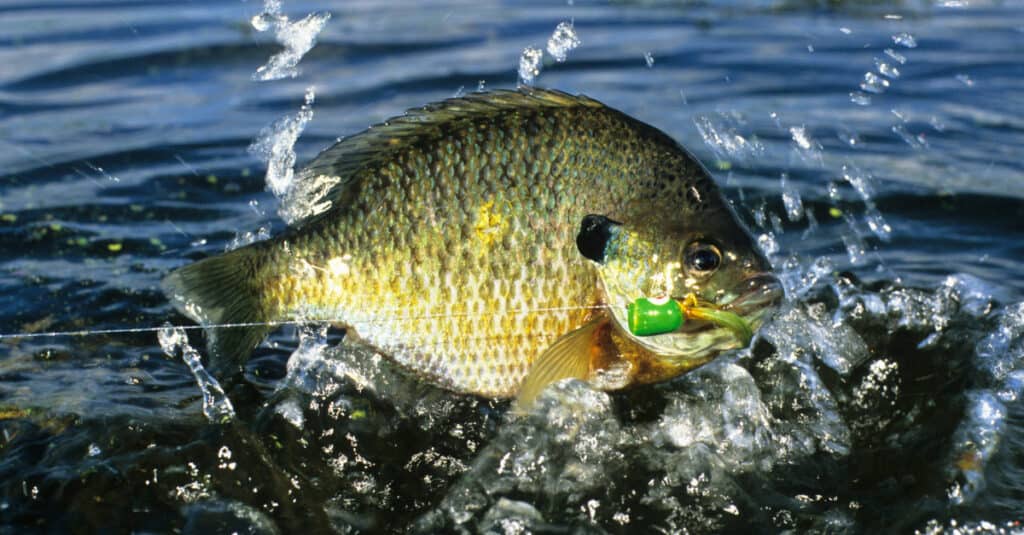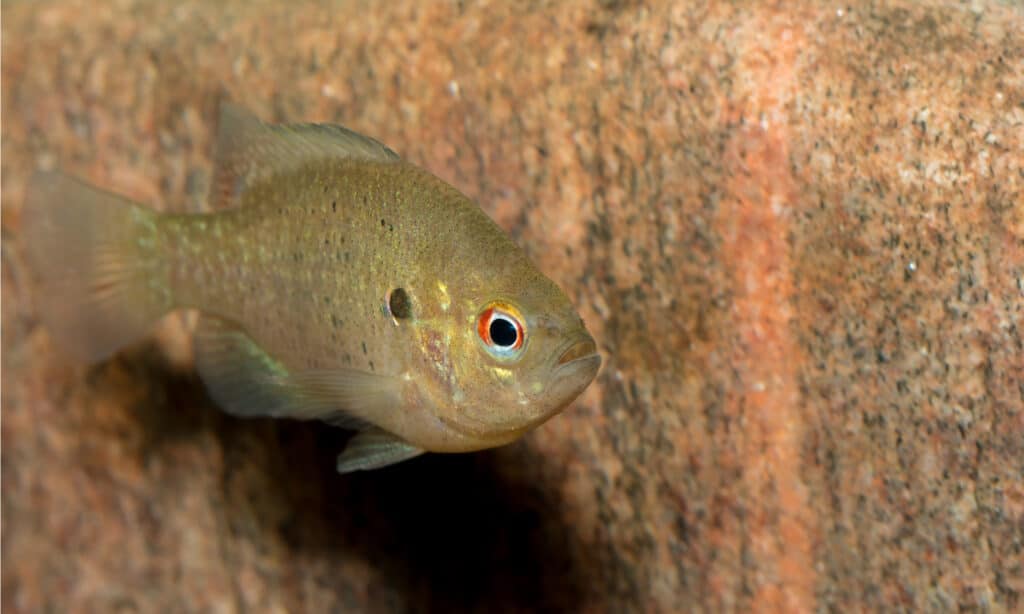Are you planning to break Florida’s record for the largest bluegill ever caught? If so, let’s see what you’re dealing with! Keep reading to learn what bluegills are, what the largest one caught in Florida is, and some tips on catching them!
What Is a Bluegill?

©iStock.com/mpwoodib
Bluegill fish are scientifically called Lepomis macrochirus. People often call them “copper nose,” “brim,” “bream,” or “sunny.” They usually live in the rivers, streams, ponds, lakes, and wetlands east of the Rocky Mountains. Bluegills prefer inhabiting calm, weedy waters because they like remaining hidden.
These fish have a forked tail and a long dorsal fin. The sides of their heads and chins are typically dark blue. The abdomen and breasts are yellowish. Breeding males usually have bright orange breasts. Although that’s their typical coloration, their pattern is highly dependent on the presence of neurally controlled chromatophores under their skin, meaning the cells that produce color. However, what’s distinctive about their coloration is that if they’re threatened or caught, bluegills will immediately display 5-9 vertical bars on their sides. Moreover, they can be easily distinguished from other fish by their vertically flattened bodies.
Young fish eat rotifers, water fleas, copepods, and insects, while adults most often feed on aquatic insect larvae but can sometimes catch shrimp, zooplankton, snails, or crayfish.
How Large Do Bluegills Get?
Bluegills aren’t a large fish species, as they usually grow up to around 12 inches and have an average weight of around 2.6 pounds.
What’s the Largest Bluegill Ever Caught in Florida?

©iStock.com/stammphoto
The largest bluegill ever caught in Florida weighed 2.95 pounds. It was caught on April 19, 1989, by John Lemaster at Crystal Lake, Washington County. The fish measured 13.75 inches long and had a 15.25-inch girth.
If we compare this fish’s weight to the species’ average weight, we’d say this was a pretty good catch. Moreover, considering that no one could beat the record set such a long time ago, the bluegills in Florida probably rarely exceed this weight.
When Is the Best Time to Catch Bluegill in Florida?
Anglers recommend fishing for bluegill from May to August. That’s when bluegills get together to spawn. On average, the peak of their spawning season is in June, when the waters have a temperature between 67 and 80 degrees Fahrenheit. At that time, these fish aggressively look for prey and attack any hook near them. Before fishing, check whether the temperatures won’t drop during that day, as the fish may push back into deeper areas if the temperature isn’t suitable for spawning.
However, some anglers advise that you can also catch bluegill during the fall and winter. While in other regions, it might be more difficult to catch them, you shouldn’t have any problems in Florida, as the state’s average high temperature during the winter is 62 to 76 degrees Fahrenheit. However, it also depends on where exactly in Florida you’re fishing. For instance, in Key West, the temperatures can drop as low as 41 degrees, which is when fishing might require more effort from your side, as bluegills will wander around only to look for food, typically moving very slowly.
As for the best time of the day to catch this species, this depends on the season and temperature. If it’s warm outside, you’ll have more chances to catch bluegills in the morning and evening. On the other hand, if temperatures drop, bluegills may be more active during the day when the water is warmer.
Tips on How to Catch Bluegills
Anglers believe that catching bluegills is done best with live bait. Here are some options you can choose from:
Some anglers claim to have caught bluegills using only a bare hook!
Further, remember that bluegills are more attracted to vibrant colors like yellow, green, or orange. You can also use polarized sunglasses to find their spawning beds.
Moreover, if you’re trying to catch bluegill during the non-spawning season, you have to throw the bait into deep waters fast, so it goes past the smaller sunfish.
What’s the Largest Bluegill on Record?

©Clint H/Shutterstock.com
According to the International Game Fish Association, the world’s largest bluegill was caught in Alabama on April 9, 1950. The fish weighed 4 pounds 12 ounces, and was caught at Ketona Lake by T. Hudson. The specimen measured 15 inches long!
On the other hand, the All-Tackle Length World Record is held by an 11.8-inch-long bluegill caught at the Colorado River in Arizona. It happened less than a year ago, on June 14, 2022, and the angler involved was Joshua Daniels. Another fish of the same length was caught on the 1st of September 2020 at Lake Perris, California, by Bob Gaines.
However, we’ve found some sources listing some longer fish, including one caught on the 2nd of May 2004 at Goldwater Lake in Arizona, which weighed 3 pounds 15.68 ounces and had a length of 15.75 inches. So why doesn’t this fish hold the world’s record? That’s because the All-Tackle Length Record category has only recently been established. Moreover, the fish wouldn’t even be accepted for the “record race,” as the All-Tackle Length Record implies that the fish must not be harmed, as it’s a 100% release category.
Up Next:
- Bluegill vs Sunfish: The 5 Key Differences Explained
- Sea Monsters! The 10 Biggest Trophy Fish Ever Caught in Florida (3 are More than 1,000 lbs.!)
- The 10 Best Fishing Spots in Florida This Summer
The post Discover The Largest Bluegill Ever Caught in Florida appeared first on AZ Animals.
from Animal News, Facts, Rankings, and More! - AZ Animals https://ift.tt/Efw34Or